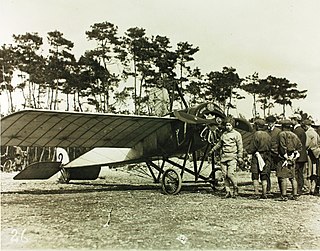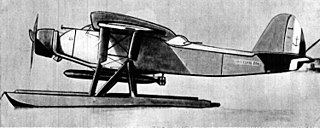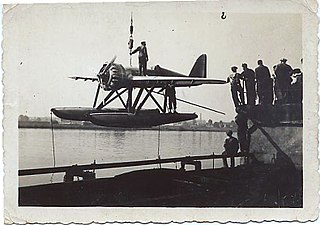Design and development
In late 1932, the Société des Avions Bernard proposed to build a floatplane fighter to meet the requirements of the French Navy for a shipboard fighter suitable for operation from the catapults of its Battleships and Cruisers. The Bernard design, the H.52, was a mid-winged monoplane based on its Bernard 260 landplane fighter, using the same wings, rear fuselage and tail surfaces as the earlier design. It was of all-metal construction, principally duralumin, with a monocoque fuselage and stressed skin cantilever wings that were integrally constructed with the centre fuselage. Leading edge slots and large flaps were fitted to the wing to lower its landing speed, while its undercarriage consisted of two main floats. A single supercharged Gnome-Rhône 9Kdrs radial engine powered the aircraft [1] [2] [3]
The first of two prototypes flew on 16 June 1933, with the second flying in 1934. No production followed, with Bernard choosing to develop a new fighter to meet the requirements of the French Navy, the Bernard H.110. This had a similar layout, with wooden wings and a more powerful engine fitted, but had no more success in attracting orders than the H.52, the French Navy eventually selecting the Loire 210. [1]

The Bloch MB.210 and MB.211 were the successors of the French Bloch MB.200 bomber developed by Société des Avions Marcel Bloch in the 1930s and differed primarily in being low wing monoplanes rather than high wing monoplanes.

The Dewoitine 37 was the first of a family of 1930s French-built monoplane fighter aircraft.

The Morane-Saulnier M.S.225 was a French fighter aircraft of the 1930s. It was produced in limited quantities to be used as a transitional aircraft between the last of the biplanes and the first monoplane fighters.

The Loire 210 was a French single-seat catapult-launched fighter seaplane designed and built by Loire Aviation for the French Navy.

The Morane-Saulnier G was a two-seat sport and racing monoplane produced in France before the First World War. It was a development of the racing monoplanes designed by Léon Morane and Raymond Saulnier after leaving Borel and, like its predecessors, was a wire-braced, shoulder-wing monoplane. Construction was of fabric-covered wood throughout, except for the undercarriage struts which were of steel tube.
The Morane-Saulnier AF, also known as the Morane-Saulnier Type AF and the MoS 28 was a French First World War single-seat biplane fighter prototype from 1917.

The Latécoère 290 was a torpedo bomber floatplane produced in France during the 1930s. Designed by Latécoère in response to an Aéronavale specification for such an aircraft, the 290 was based on its successful Laté 28.3 mail plane. It was a conventional high-wing, strut-braced monoplane that carried a single torpedo externally under the fuselage.

The Farman NC.470 was a French twin-engined floatplane designed as a crew trainer for the French Navy. It was used in small numbers for both its intended role as a trainer and as a coastal reconnaissance aircraft at the start of World War II.
The Latécoère 550 was a four-engined French seaplane, designed in the early 1930s as a bomber/torpedo bomber. Though initial handling problems were partly resolved, the aircraft was deemed too slow and did not go into production.

The Bernard H.V.40 was a racing seaplane designed by Société des Avions Bernard for the French government to compete in the 1929 Schneider Trophy.
The Farman F.420 was a twin engine monoplane, built in France in the mid-1930s to compete in a government contest for an aircraft capable of fulfilling bomber, fighter and reconnaissance roles. Two prototypes were constructed but no production followed.
The SNCASE SE-400 was a prototype French twin-engined coastal patrol floatplane of the Second World War. A single example was flown, but development was abandoned in May 1940 owing to the German invasion of France.

The Bernard 60 T and 61 T were closely similar, three engine, twelve seat passenger transports designed in France between 1929 and 1933. They were not a success and only one of each was built.
The Bernard H 110 was a single engine, single seat monoplane floatplane fighter designed for a French Navy competition. It flew in 1935 but had only made four test flights when the Bernard company was declared bankrupt, preventing further development.
The Bernard 160 was a three engine, multi-role monoplane designed in the early 1930s to meet a French government call for aircraft suited to policing and medical duties in its African colonies. Two prototypes were built and tested, but no further orders were placed.

The Bréguet 460 Vultur was a French bomber of the 1930s. Few of these twin-engined monoplanes and its variant, the Breguet 462 Bréguet , were built. At least one Breguet 460 was sold to the Spanish Republican Air Force during the Spanish Civil War.

The SNCAC NC-600 was a prototype French twin-engined long-range fighter aircraft, developed by SNCAC from the earlier Hanriot H.220 fighter. The type never entered service, with development being ended by the French surrender in June 1940.
The Wibault 313, Wibault Wib 313 or Penhoët Wibault Wib 313 was a single engine, single seat low wing monoplane fighter aircraft, designed and built in France in the early 1930s. It was entered into a government competitive tender programme but was not ordered.
The Caudron 02 was a French high altitude single seat fighter that was flown in November 1917.
The Bréguet 610 was a reconnaissance seaplane built in 1934 by the Bréguet company.
This page is based on this
Wikipedia article Text is available under the
CC BY-SA 4.0 license; additional terms may apply.
Images, videos and audio are available under their respective licenses.












